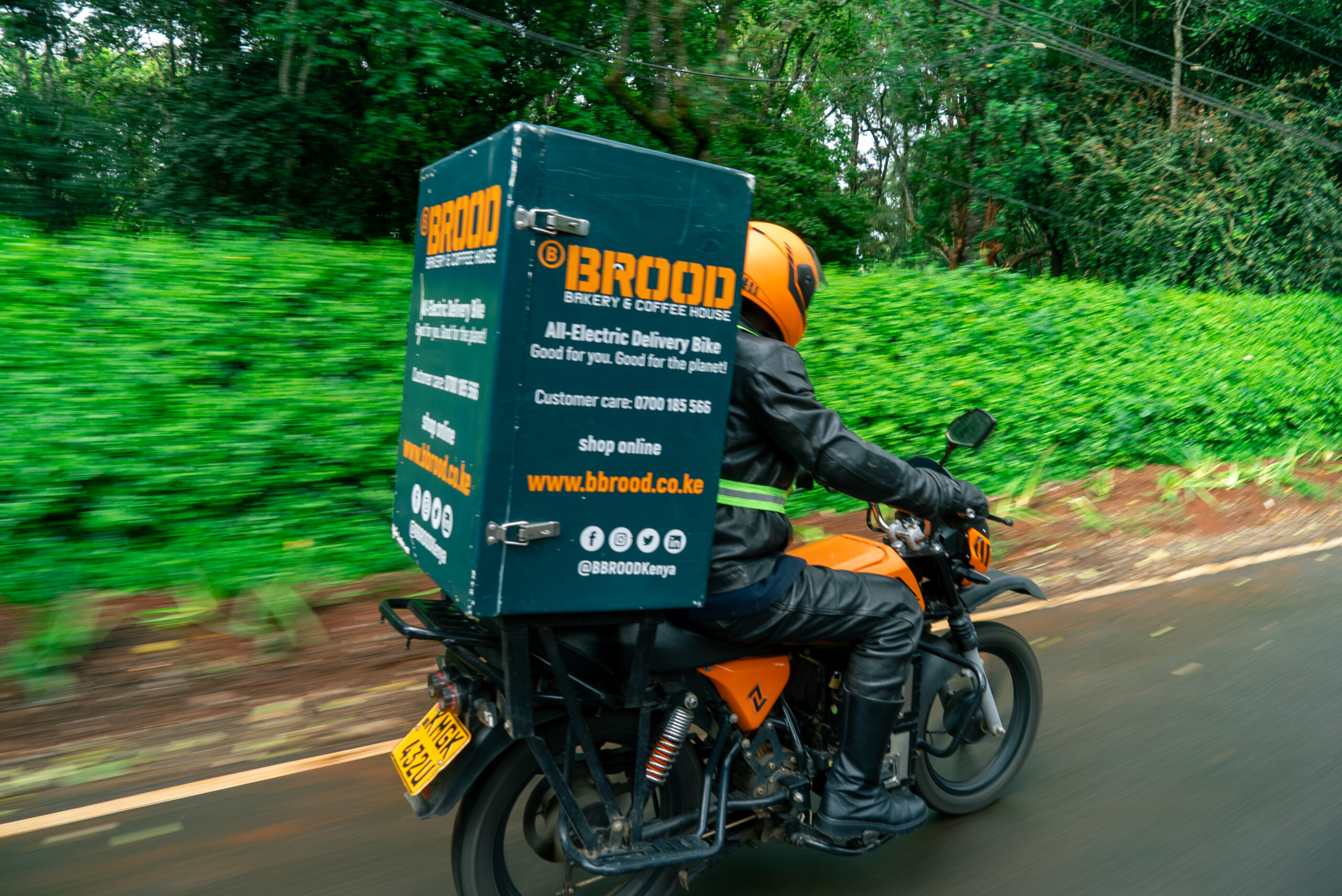Sign up for daily news updates from CleanTechnica on email. Or follow us on Google News!
September witnessed plugin EVs take a record 97.5% share in Norway, up from 93.0% year on year. BEVs crushed all other powertrains, taking 96.4% share, also a new record, with PHEVs a distant runner-up at 1.1% share. Overall auto volume was 12,966 units, up 25% YoY. Tesla dominated, taking around a third of the entire auto market.
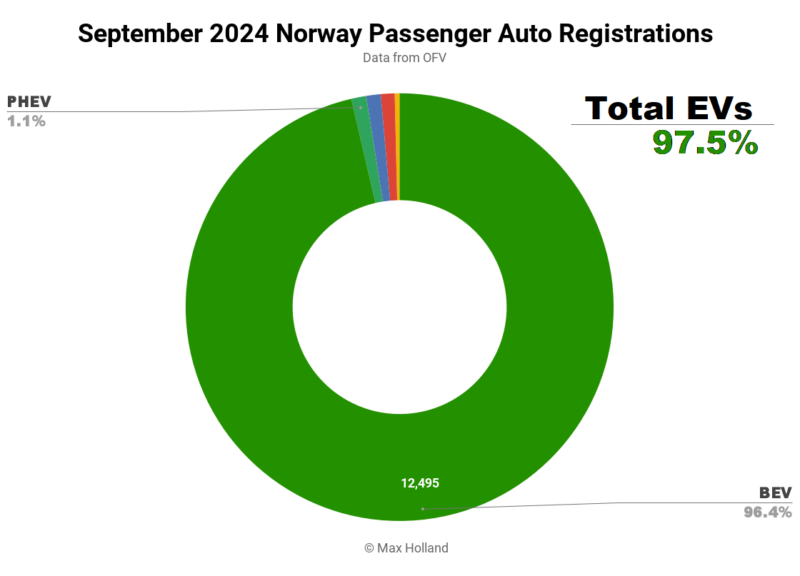
September’s auto sales saw combined EVs take a record 97.5% share in Norway, comprising a remarkable 96.4% full electrics (BEVs), and 1.1% plugin hybrids (PHEVs). These compare with YoY figures of 93.0% combined, with 87.0% BEV and 6.0% PHEV.
With many older vehicle designs — mostly fossil-burning — being taken off the market after the new GSR2 safety regulations became mandatory in Europe from early July, BEVs are now pretty much the only game in town. PHEV powertrains led the also-rans, albeit with a measly 1.13% share, just ahead of HEVs at 1.10%. Both diesel-only and petrol-only powertrains are now running on fumes, at 1.04%, and 0.37% share, respectively.
What are the few non-BEV models still being bought by Norwegian consumers? Unsurprisingly Toyota is a major culprit, with the Yaris, Corolla (as mostly HEVs) combining for 133 sales — over 1% of the auto market — and the RAV4 (some HEV, some PHEV) selling another 46 units. If we add-in Toyota’s other plugless models, the Supra, the Hilux, and the Land Cruiser, the company likely made 200 combined monthly sales of the mostly-plugless vehicles.
Put differently, Toyota alone was potentially responsible for around half of the 325 plugless vehicles sold in Norway in September. So much for Toyota’s alleged “Continuous Improvement” ( 改善).
To be fair, Toyota did also manage to sell 606 units of the bZ4X BEV in September, and a few dozen units of its Proace BEV vans. This doesn’t change the fact, however, that Toyota remains the main auto brand whose vehicle offerings are keeping Norway with one foot toe in the past.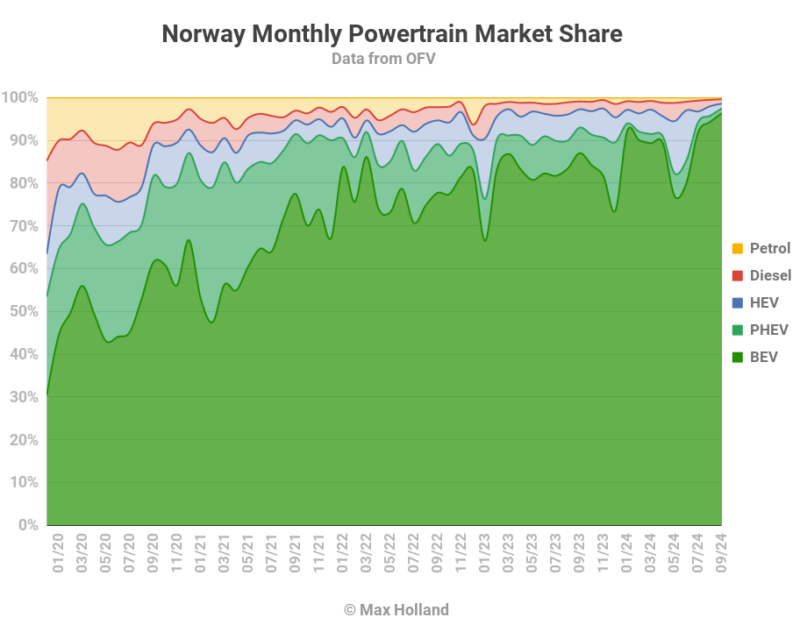
Best Selling Models
Tesla had a blow-out month in September, with both the Tesla Model Y, and the Tesla Model 3, each seeing more than 2,000 units registered. Tesla took around a third of Norway’s total auto sales for the month.
In third place was the Volvo EX30 with 741 units, just ahead of the Skoda Enyaq (736 units). The aforementioned Toyota bZ4X came in fifth.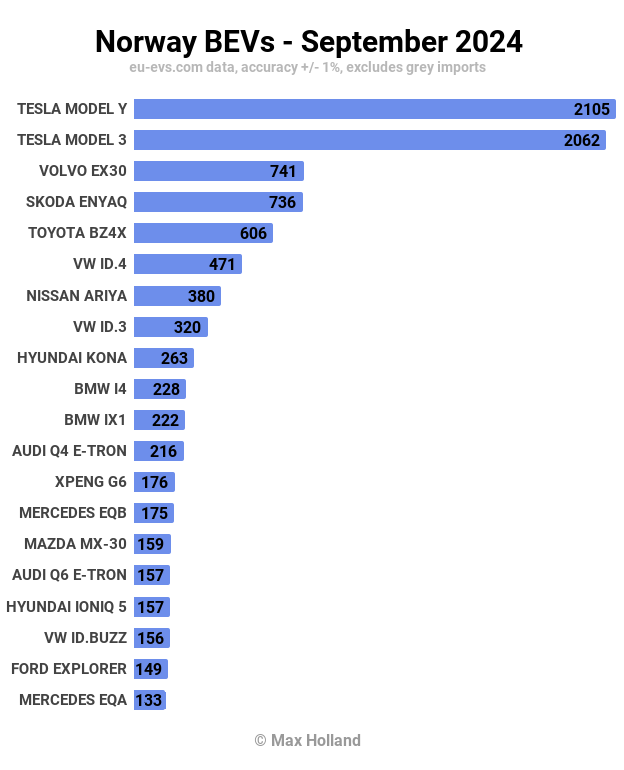
Whilst most of the top 20 models were familiar faces, there were a few notable moves. The new Xpeng G6, which debuted only in July has already climbed into the chart, with 176 units, and 13th spot. Likewise, the new Audi Q6 e-tron scored 176 units, and 16th spot. Not to be overlooked, the new Ford Explorer, which only launched in August with an initial 4 units, grabbed an impressive 148 sales in September, taking 19th spot.
More impressive still was a very strong debut from the new Porsche Macan, (a close cousin of the Audi Q6) which saw 84 units registered in September, and landed in 26th spot. Expect it to climb into the top 20 in the next month or so.
Another debutant was the new Peugeot e-5008, a mid-large (4791 mm) SUV, starting from 479,900 NOK (€40,935). One key feature of the 5008 is that it offers 7 seats, and far undercuts the price of other 7 seaters, such as the Kia EV9, and Volkswagen ID.Buzz. The new Peugeot scored 48 initial sales in September and should climb from here.
Talking of 7-seaters, the even larger (5039 mm) new Volvo EX90 SUV has finally arrived in Norway, with 1 (one) initial unit in September, but we can expect many more to follow. The challenge will be the pricing, with the variant now on sale starting from an eye-watering 903,500 NOK (€77,070). This is considerably more than even the Kia EV9 or VW Buzz, and around twice the price of the Peugeot e-5008. Perhaps this is a high-end launch edition, and Volvo will offer more affordable trims in due course. We will keep an eye on it.
Let’s now check up on the longer-term rankings:
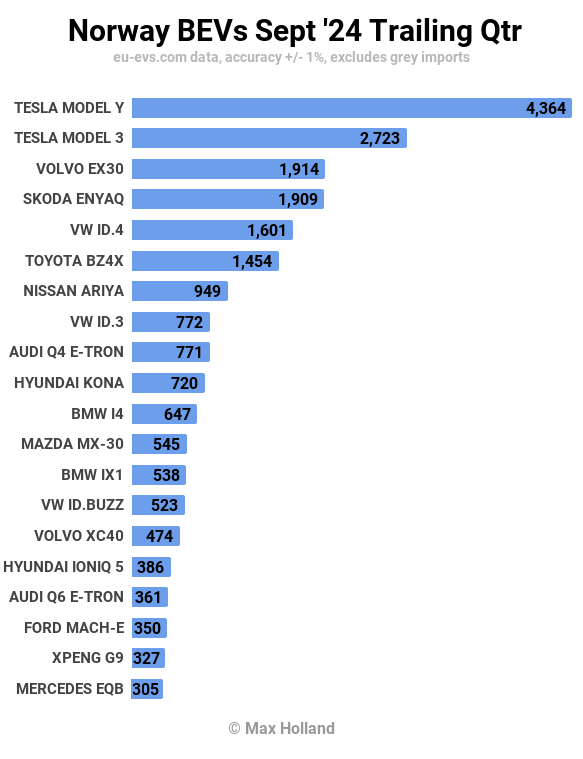
Tesla Model Y is evidently still very dominant, and its older sibling, the Model 3, has jumped up into second place thanks to the strong end-of-quarter push. The Volvo EX30 remains popular, just fractionally ahead of the Skoda Enyaq in fourth.
Note that the Audi Q6 e-tron has already entered the 3-month chart, in 17th, with 361 units, and we can expect the Xpeng G6 to likely enter next month. Further out, the Porsche Macan, and perhaps the Ford Explorer too, may have a chance to climb onto the bottom of the chart by the end of this year, let’s wait and see.
 Chip in a few dollars a month to help support independent cleantech coverage that helps to accelerate the cleantech revolution!
Chip in a few dollars a month to help support independent cleantech coverage that helps to accelerate the cleantech revolution!
Norway Fleet Transition Update
The Elbilforening has just released new fleet data, so we can update our transition charts and analysis. As of the end of September 2024, BEVs share stands at 26.5% (and 760,903 units), and PHEVs share at 7.2% (208,020).
The BEV share of the fleet has actually only increased by 2.9% over the past 12 months, whereas across 2022, it increased by 4.9%. This is largely because auto sales volumes in 2024 have been relatively slow compared to past couple of years, despite new sales now being almost all BEV. You can see the gradient of green section in the graph below has cooled slightly over the past 12 months.
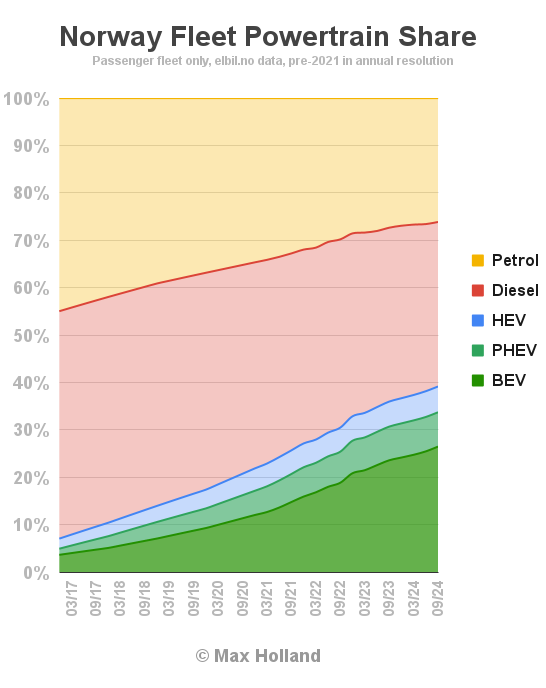
Nevertheless, the transition is still going ahead – BEV share has just crept past petrol-only share (26.1%) as covered by Jepser in his recent article. That’s a good milestone, though in fact, the diesel-only fleet is larger and perhaps more difficult to shift (being on average, newer and more expensive vehicles, and arguably more durable, than the petrol-only fleet).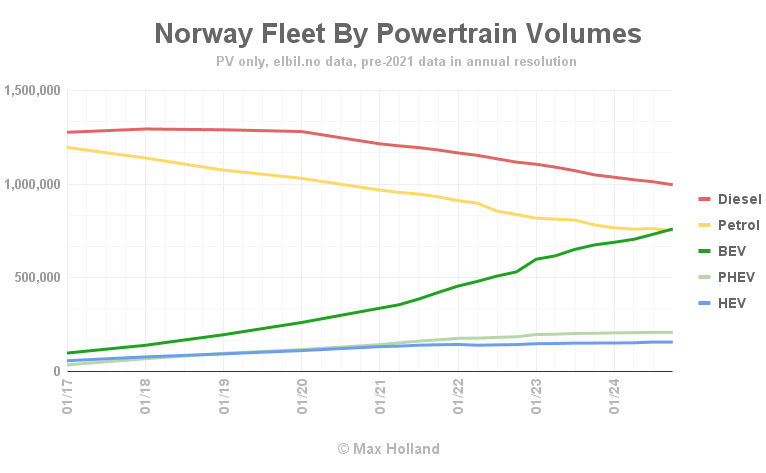
However, if we add together PHEV and BEV fleets, combined plugins are not far off the share of the diesel fleet, currently 33.7% vs 34.7%, and will certainly overtake by the end of 2024. The diesel fleet has also just dropped under 1,000,000 units for the first time (996,488 units) since peaking at almost 1,300,000 units in late 2017.
Beyond the raw fleet numbers, what we are most interested in is annual kilometers (KM) travelled on electricity (sourced almost entirely from renewables in Norway) rather than by combustion powertrains burning fossil fuels.
Recall that the average new car (now essentially all BEVs) gets driven many more annual km than an average old car (now almost entirely ICE cars). The average BEV’s annual KM driven overtook the average diesel’s in 2021 already, mostly because the average BEV is very new, and the average diesel is rather old (see this analysis for a chart).
This means the Norwegian auto fleet’s summed annual KM travelled on electricity vs KM travelled on fossil fuels, is transitioning much faster than the actual change in fleet composition. I estimate that KM driven on electricity (combining both BEV and PHEV electric KM) have already overtaken diesel-only KM, and will overtake all plugless KM driven by the end of 2026 or so. For my reasoning, and for more data and analysis of these trends, see my fleet transition deep-dive from a few months ago.
Outlook
Now that over 95% of Norway’s auto sales are BEVs, the challenge to focus on is the speed of transition of the fleet. As BEVs become ever more affordable, as well as less expensive to run, per km driven, this should – other things being equal — accelerate the rate of retirement of old ICE cars, and their replacement with much more economical BEVs.
In other words, BEV’s advantages should – in principle – lead to higher-than-normal auto sales until everyone has transitioned over to the newer and more cost-effective (and more durable) technology. However, the price of entry to that zone of overall savings is still a factor. And that decision to invest in that initial cost of entry, to reap the later savings, is affected by the state of the broader consumer economy.
Norway’s broader economy is erratic at the moment, with 2024 Q2 (latest data) showing YoY GDP up by 4.2%, thanks somewhat to government stimulus, following 2 of the previous 3 quarters in negative territory. Inflation is at 2.6%, interest rates are high at 4.5%, and manufacturing PMI is lacklustre, at 51.8 points in September, from 52.0 in August.
This economic malaise is not going to help the relative volume of new car sales, or speed the fleet’s replacement rate of old ICE cars with new BEVs.
What do you think about Norway’s EV transition? Is a 96+% BEV share of new sales a “good enough” practical outcome such that other things should become a focus, like vans, trucks, and buses? What needs to happen for the remaining couple percent of non-BEV sales to disappear entirely (if that matters)? Please share your thoughts in the comments below.

Have a tip for CleanTechnica? Want to advertise? Want to suggest a guest for our CleanTech Talk podcast? Contact us here.
Latest CleanTechnica.TV Videos
CleanTechnica uses affiliate links. See our policy here.
CleanTechnica’s Comment Policy





